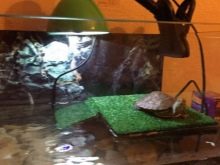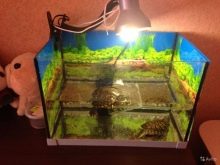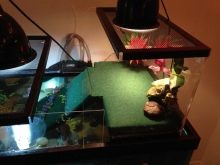Choosing a lamp for red-eared turtles
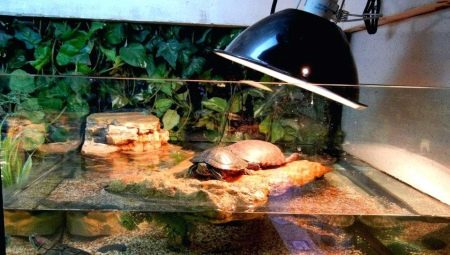
It is no secret that keeping any animals requires appropriate knowledge, skills, as well as certain financial and significant time expenditures. Naturally, red-eared turtles are no exception in this case. A frivolous attitude towards the acquisition of such reptiles often has extremely negative consequences. Some do not even suspect what conditions are necessary for such pets. That is why queries on the topic “choose the right lamps for the aquaterrarium” are becoming more and more relevant.

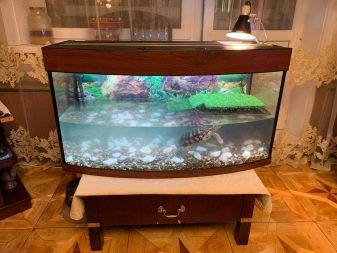
Why do you need a lamp?
First of all, it is important to recall that red-eared turtles, like all representatives of the reptile class, are cold-blooded creatures. That is why their state in nature directly depends on the energy of the Sun. Adequate amount of light and heat is a prerequisite for their existence.
Ultraviolet radiation and the corresponding temperature regime are key factors in the context of the main processes in the body of the animals in question.
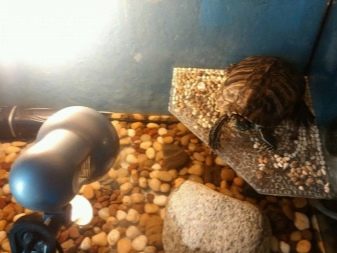

Their life passes under the rays of the Sun, thanks to which:
- the body actively assimilates calcium;
- activity increases;
- strengthens the immune system;
- reproductive behavior is stimulated;
- improves color recognition.
Without exposure to ultraviolet radiation, the reptile is doomed to death, which can be caused by rickets and a number of concomitant pathologies, as well as metabolic disorders. Lamps can help prevent trouble, which can replace natural sunlight, which is so necessary for the health of the animal. They perform fundamental functions in the context of the rules for keeping turtles.
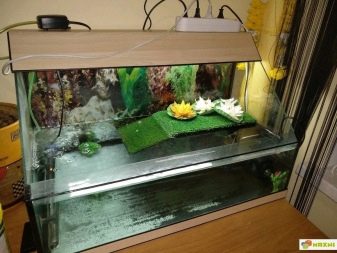
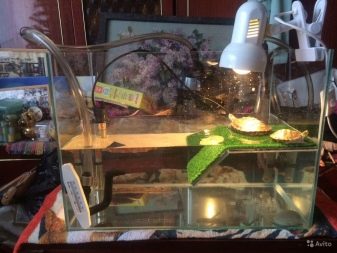
The first is to provide sufficient ultraviolet light intensity. It should be noted that fluorescent lamps are a source of two types of radiation. And initially we are talking about UV-B waves, contributing to the body's receipt of vitamin D. First of all, it is responsible for the production of vital calcium, without which rickets inevitably develops.
The second type of radiation is UV-A, which allows turtles and other reptiles to see each other and their food better. Such rays have the most positive effect on the behavior of the animal and its activity. Taking all factors into account, it can be understood that special ultraviolet lamps are a must in the course of the competent keeping of reptiles, including red-eared turtles, in captivity. The absence of a source of the described radiation often leads, in particular, to softening of the shell, as well as fractures of the paws. Added to this is lack of appetite and minimal mobility. Among other things, without UV it is useless to feed the animals vitamin D as it will not be absorbed.
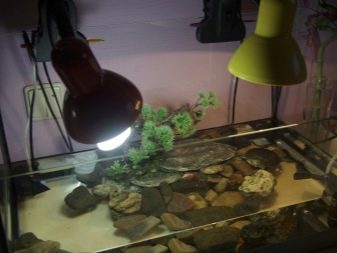
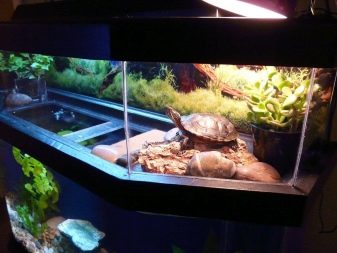
Another paramount function is the creation of a heat source. It is important to remember that the metabolism of turtles is the lowest, including among cold-blooded animals. Moreover, almost all vital functions depend directly on the ambient temperature. It is enough warmth that determines the activity of the animal. Without it, such processes as complete digestion and assimilation of food will also be impossible. Based on all of the above, we can confidently conclude that additional heating is required in the aquarium. Otherwise, all processes in the body of the red-eared turtle slow down, which leads to negative consequences.
The tandem heating and ultraviolet lamps will be an alternative to the sun for a reptile at home. As a rule, these sources of light and heat work most of the day, that is, they copy the heavenly body.
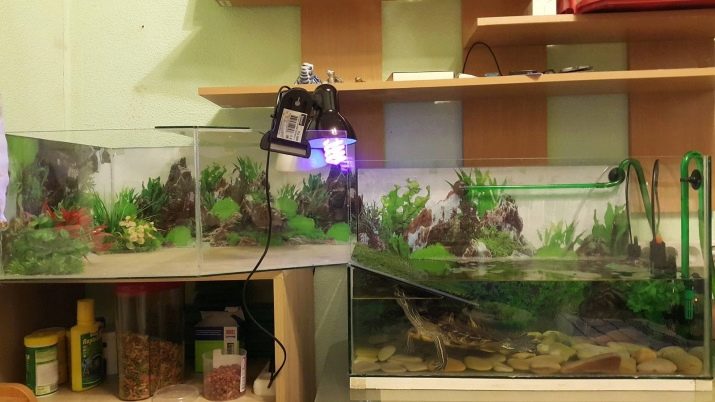
Views
Any terrarium for a red-eared turtle should have two zones: a body of water and land. At the same time, on a kind of coast, the temperature varies in the range from 32 to 40 degrees. Taking into account all the requirements for the maintenance of reptiles, breeders install two lamps at once in aquariums. One of them is a source of vital ultraviolet radiation, and the second is a heater.
But it should be noted that there is now a fairly wide range of lamps of different types on the market. They all have their own characteristics and perform certain functions. As a result, turtle owners are able to choose the most suitable options based on their preferences, experience and financial capabilities.
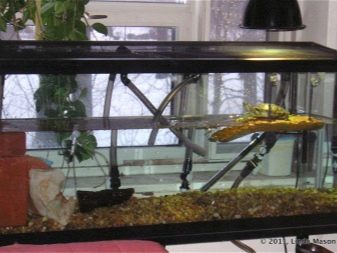
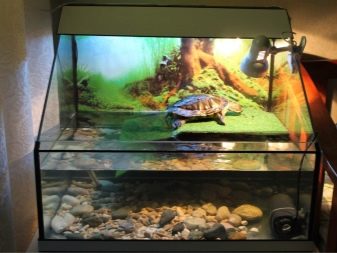
Ultraviolet
This type of lamp is one of the most important elements of arranging a comfortable habitat for the red-eared turtle. To date, there is no alternative to such UV sources. When choosing these lighting devices, first of all, attention is paid to parameters such as power and wavelength. In this case, an equally important point will be the duration of the daily operation of the lamp.
Sometimes turtle breeders replace UV lamps with conventional ones that have a filament. However, this approach is erroneous, since the UV dose released by the latter is negligible. Some reptile owners find natural light to be indispensable and sufficient as a source of the necessary radiation. However, it is possible to take the animal out into the sun only in the warm season, since it is very sensitive to low temperatures.
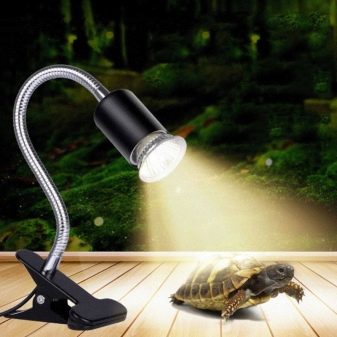
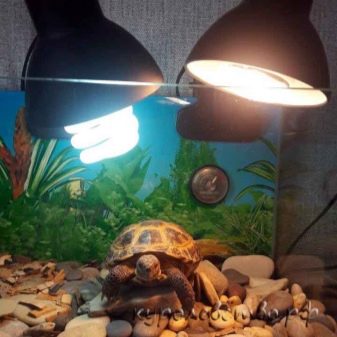
Considering all the features and advantages of UV lamps, it is worth focusing on the inadmissibility of using the following options:
- medical;
- lamps installed in banknote detectors;
- phytolamps;
- lighting devices for aquarium fish;
- lamps used by nail artists.
All of these models are not able to replace the ultraviolet options, which are suitable specifically for keeping reptiles. This is due to the emission of waves of a certain spectrum at the appropriate dosage.
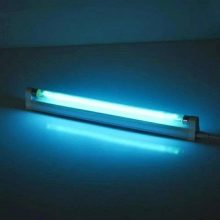
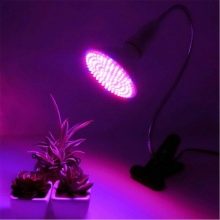

There are lamps that provide UV rays with a range that allows parallel and heating of the aquarium. However, it is rather difficult to find such models on sale.
It should be remembered that the life of modern lamps of the type in question is 1 year. After this period, the radiation intensity sharply decreases, based on which it is recommended to replace the device. Experienced breeders advise to do this approximately one month before the end of the indicated lamp duration, in order to eliminate the risk of deterioration of the reptile's well-being.
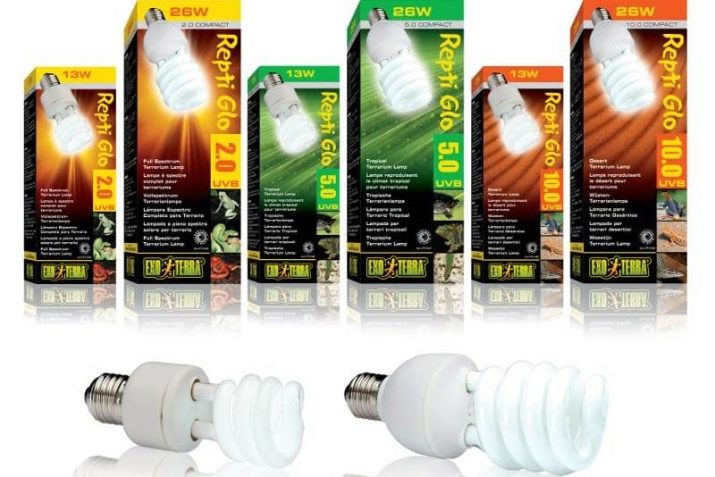
Heating
In order to ensure the most comfortable and safe conditions of detention over the land area in the aquaterrarium, it is required to install a heat source. Most often, heating lamps are initially located at a distance of about 30 cm from the island, after which this parameter is adjusted until the desired temperature is reached. An alternative would be to select the power of the luminaire. Also, turtle owners often use special models of lamps that do not emit light at all, but at the same time they effectively warm up the desired area of the aquarium.

In principle, an ordinary incandescent lamp can be supplied for heating. At the same time, devices with a capacity of 40 to 60 watts are installed in small and medium terrariums, and up to 75 watts in larger ones. In addition, the following types of lamps are currently used.
- Mirrored with directional action. Half of the surface of the light device in this case has a corresponding reflective coating. It is precisely this that provides the directionality of the radiation, due to which it is possible to direct heat to a specific place, and not scattered, like the "Ilyich's lamp". Given this technical feature, 20 watts will be enough to heat the land in the terrarium.
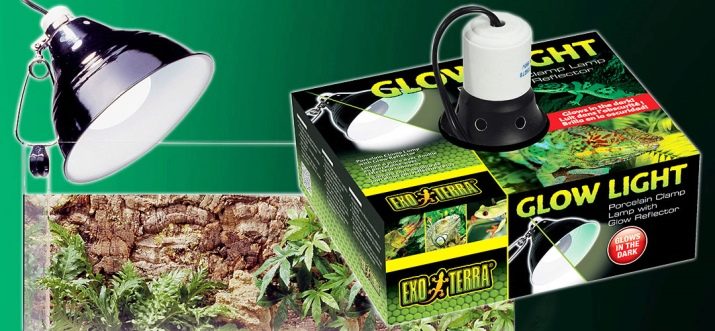
- Infrared, which are lighting devices that have been specially developed for equipping terrariums. As a rule, they are used to maintain the desired mode at night when the room temperature drops below 20 degrees. The main feature in this case is the absence of visible light against the background of rather intensely radiated heat.
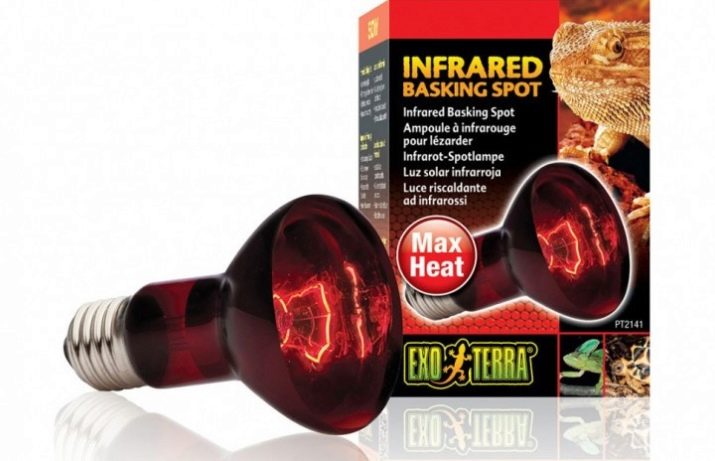
- Ceramic, intended for use mainly at night. As in the previous case, these lamps do not provide visible light, but they can effectively warm up the aquarium. Taking into account their characteristics, they are located at a distance of 40-50 cm from the pet. One of the main advantages of such lamps is their maximum safety, including when exposed to water. Such night devices can be used in rooms with high humidity.
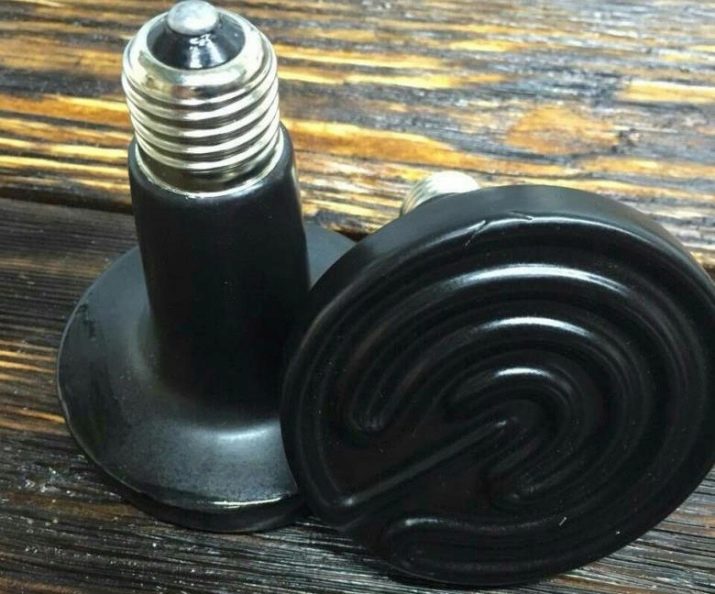
- Mercury gas discharge, which is a source of visible light and strong heat. One of the key competitive advantages in this case is a long service life. In addition, the self-regulating throttle lamp provides a high UV-B level.
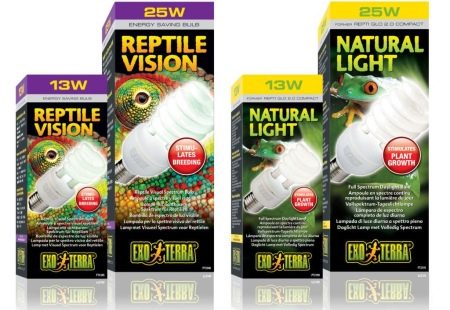
Now you can buy ordinary light bulbs or mirrors at almost any hardware store. Infrared and nocturnal (ceramic) models should be found at retail outlets that specialize in pet supplies. It is important to remember that the power of the heating lamps should not exceed 60 W. They also include them for an average of 8-10 hours. It turns out that they should function throughout the day, and at night, when the inhabitants of the aquariums are sleeping, they need to be turned off.
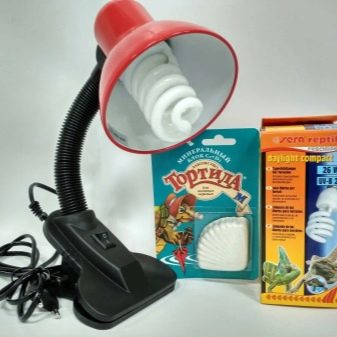
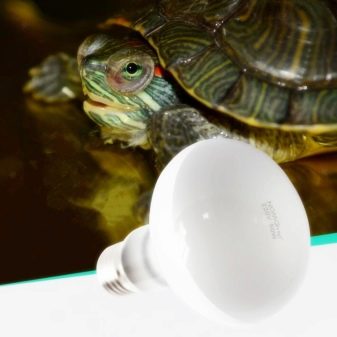
Criterias of choice
To understand which lighting fixture is best for your reptile and how to choose the right one, there are a number of key performance indicators to consider. And in this situation we are not only talking about the power of the devices used to equip the corresponding aquariums. First of all, it is worth focusing on the percentage of medium waves (UV-B). It is this parameter that determines how much the turtle will receive the calcium necessary for its full life. This indicator should vary in the range from 5 to 10%.
It should be noted that such a spectrum provides the animal's body with a complex of essential substances. Short waves (less than 2%) are potentially dangerous, therefore it is highly undesirable to place them in reptile terrariums. By the way, during the pregnancy of the red-eared turtle, the indicator in question can be increased to 12%.
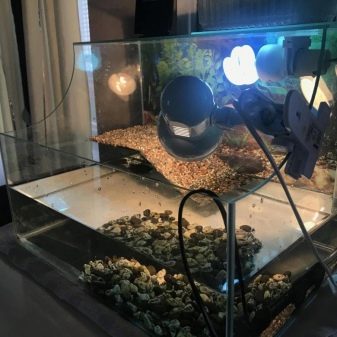
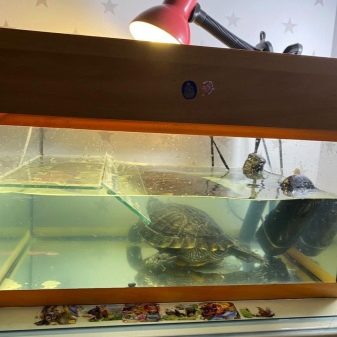
The next parameter defines long ultraviolet wavelengths (UV-A). In this case, the recommended value is at least 30%. It is important to take into account that most often the specified parameters are selected individually in each specific case. At the same time, experts strongly recommend using lamps in a certain way. In particular, for aquatic animals, ie red-eared turtles, models with UV-B values in the range of 5–8% are required. If the animal is sick or weakened, then this indicator should increase to 10-12%.
In some cases, the specified information is missing on the packaging of the lamps. This will be a good reason for refusing to buy. Or you will need to try to clarify such important characteristics with the seller. It is also recommended to pay attention to the manufacturer. For example, when ordering American lamps, you can get devices designed for 110 V.

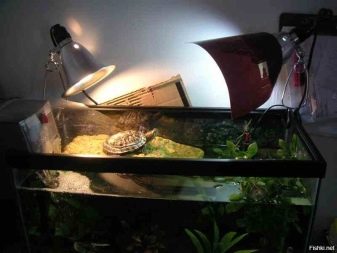
In addition to all of the above, it is necessary to highlight one more important point related to the choice of lighting for the aquarium. So, UV lamps can be replaced with erythemal lamps, which are used for artificial tanning. But it is worth remembering that the radiation in them is more powerful, and therefore they are turned on for only 5-10 minutes a day. Also, this kind of light, if it gets into the eyes of a turtle, can cause significant harm.
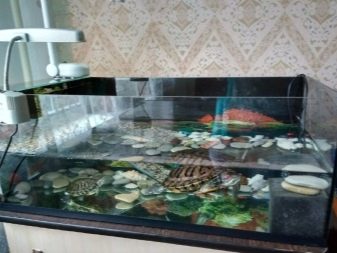
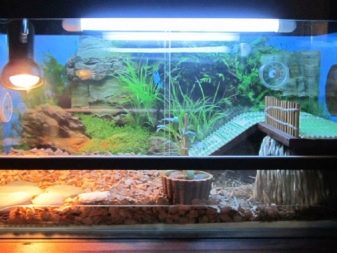
Accommodation rules
Today, different types of lamps for aquaterrariums are on sale, and each of them has its own characteristics that determine how the lamps should be installed. For example, tubular models will require special shades or grooves. This option will be a rational solution when equipping large aquariums. Compact light sources are screwed into a regular base. At the same time, the operation of a metal vapor lamp requires a starter. Among other things, when installing ultraviolet and heat sources, it is important to ensure that the pet cannot loosen the installation site. Do not forget about the safe location of the wiring in order to eliminate the risk of electric shock.
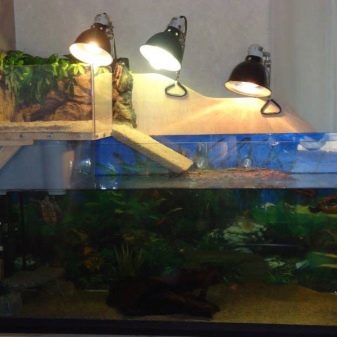
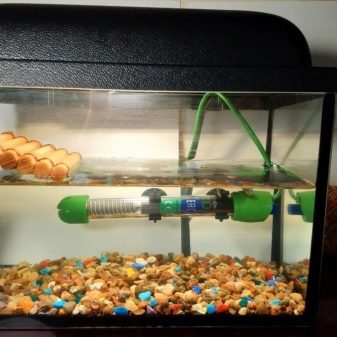
Taking into account all the nuances, in order to correctly install the lamps, you need to focus on the following key points:
- type of UV and heat source;
- the distance from the lamp to the pet's resting place;
- features of the reptile itself;
- temperature regime in the room and in the aquarium;
- illuminated area.
It is important that the light is evenly distributed throughout the enclosure and that there are no dark areas. It is not recommended to place lights on the side, which will irritate the turtle. It should be remembered that the heating lamp, as a rule, should function mainly during the daytime. The duration of the work of the sources of UV rays is determined, first of all, by the age of the reptile.
In the absence of the ability to constantly monitor the mode of lamp use, a rational solution would be to use auto-shutdown.
